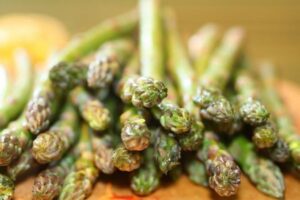Asparagus

Contents:
Season for Asparagus
Asparagus Described
How to Buy and Store Asparagus
How to Cook Asparagus
Health Benefits of Asparagus
Why Buy Natural and Organic Asparagus
Season for Asparagus April – May
Asparagus Described
“Asparagus pee” is not enough to deter us from this signature spring vegetable – nor should it be (it’s completely safe). While short, the season for asparagus marks our emergence from winter and the sweet succulence of the earth. Green asparagus may be most common, but this perennial plant from the lily family is also available in purple and white varieties, and increasingly so. The spears we know and love are actually immature shoots from an underground crown that would eventually flower and become inedible. And the often high price tag reflects the labor intensive process of hand-harvesting asparagus, well worth the effort.
How to Buy and Store Asparagus
The less time it takes to get asparagus from farm to fork, the better it will taste owing to the conversion of sugars into starch once asparagus has been picked – just one reason you may want to scope out the crop at the farmers market. When selecting asparagus, go for tightly furled tips and firm crisp stalks that are brightly colored without any splitting or signs of drying. Also, avoid wrinkled, slimy or smelly asparagus, all signs your asparagus is past its prime. Thin or thick stalks is just a matter of preference, one not superior to the other.
Once bought, use your asparagus in stride for the aforementioned reason. To store it, you can wrap the stems in a wet paper towel and keep refrigerated for no longer than 3 days.
How to Cook Asparagus
Asparagus can be boiled, steamed, roasted or grilled to perfection, and served hot or cold. Whichever method you choose, make a point of not overcooking your spears. While it’s not necessary to peel asparagus, you should chop off the fibrous base and wash your spears under cold water to dislodge any dirt. If you’re boiling or steaming and wish to preserve the brilliant color of your asparagus, immediately plunge them into a bowl of ice water and let them cool post cook. Then you can drain and dry them, warming them up if you wish with some seasonings on the stovetop. When preparing asparagus, we abide by one rule: think simple and let this veggie shine.
Health Benefits of Asparagus
Historically, asparagus has been revered for its detox, anti-aging and aphrodisiac properties, among other things. These little spears contain an abundance of the amino acid asparagine that helps to cleanse the body of waste, hence the urine smell, also helpul towards kidney function, keeping those stones at bay. You’ll find a high density of nutrients such as vitamins C, K, B, and A, and dietary fiber, manganese, copper, phosphorus, potassium and protein which make this an all-star veggie.
Why Buy Natural and Organic Asparagus
Because asparagus has a low threat form pests, not a whole lot of pesticides are used in their cultivation. So, while asparagus is relatively safe to buy when conventionally grown (some pesticides are still used), when we come across organic spears that don’t cost an arm and a leg, we go organic wholeheartedly – both for our peace of mind and to send the message that we support sustainable practices and organic farmers.
image: foodiesathome.com

